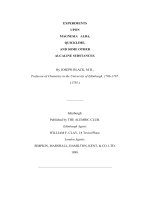The Project Gutenberg EBook of Experiments upon magnesia alba, Quicklime, and some other Alcaline pptx
Bạn đang xem bản rút gọn của tài liệu. Xem và tải ngay bản đầy đủ của tài liệu tại đây (402.26 KB, 157 trang )
The Project Gutenberg EBook of Experiments
upon magnesia alba, Quicklime,
and some other Alcaline Substances, by
Joseph Black
This eBook is for the use of anyone
anywhere at no cost and with
almost no restrictions whatsoever. You may
copy it, give it away or
re-use it under the terms of the Project
Gutenberg License included
with this eBook or online at
www.gutenberg.net
Title: Experiments upon magnesia alba,
Quicklime, and some other Alcaline
Substances
Author: Joseph Black
Release Date: February 13, 2008 [EBook
#24591]
Language: English
*** START OF THIS PROJECT GUTENBERG EBOOK
EXPERIMENTS UPON MAGNESIA ALBA ***
Produced by Bryan Ness, Greg Bergquist,
Jamie Atiga and
the Online Distributed Proofreading Team
at
Alembic Club Reprints
—No. 1.
EXPERIMENTS
UPON
MAGNESIA ALBA,
QUICKLIME,
AND SOME OTHER
ALCALINE
SUBSTANCES.
BY JOSEPH BLACK,
M.D.,
Professor of Chemistry in the University
of Edinburgh, 1766-1797.
(1755.)
Edinburgh:
PUBLISHED BY THE ALEMBIC
CLUB.
Edinburgh Agent:
WILLIAM F. CLAY, 18 Teviot Place.
London Agents:
SIMPKIN, MARSHALL, HAMILTON,
KENT, & CO. LTD.
1898.
PREFACE.
lack's Paper entitled "Experiments
upon Magnesia Alba, Quicklime, and
some other Alcaline Substances" was read
in June 1755, and was first published in
"Essays and Observations, Physical and
Literary. Read before a Society in
Edinburgh, and Published by them,"
Volume II., Edinburgh, 1756; pp. 157-225.
It was subsequently reprinted several
times during the life of the author, not only
in later editions of these Essays, but also
in a separate form. Copies of the original
Paper are now very difficult to obtain, and
the later reprints have also become
scarce.
The present reprint is a faithful copy of the
Paper as it first appeared in 1756, the
spelling, &c., of the original having been
carefully reproduced.
The Paper constitutes a highly important
step in the laying of the foundations of
chemistry as an exact science, and
furnishes a model of carefully planned
experimental investigation, and of clear
reasoning upon the results of experiment.
It is neither so widely read by the younger
chemists nor is it so readily accessible as
it ought to be, and the object of the
Alembic Club in issuing it as the first
volume of a series of Reprints of
historically important contributions to
Chemistry, is to place it within easy reach
of every student of Chemistry and of the
History of Chemistry.
The student's attention may be particularly
called to Black's tacit adoption of the
quantitative method in a large number of
his experiments, and to the way in which
he bases many of his conclusions upon the
results obtained in these experiments.
Even yet it is very frequently stated that
the introduction of the quantitative method
into Chemistry (which did not by any
means originate with Black) took place at
a considerably later date.
L. D.
EXPERIMENTS
UPON
MAGNESIA ALBA,
QUICKLIME,
AND SOME OTHER
ALCALINE
H
SUBSTANCES;
BY JOSEPH BLACK, M.D.
[1]
PART I.
offman, in one of his observations,
gives the history of a powder called
magnesia alba, which had long been used
and esteemed as a mild and tasteless
purgative; but the method of preparing it
was not generally known before he made
it public.
[2]
It was originally obtained from a liquor
called the mother of nitre, which is
produced in the following manner:
Salt-petre is separated from the brine
which first affords it, or from the water
with which it is washed out of nitrous
earths, by the process commonly used in
crystallizing salts. In this process the brine
is gradually diminished, and at length
reduced to a small quantity of an unctuous
bitter saline liquor, affording no more
salt-petre by evaporation; but, if urged
with a brisk fire, drying up into a confused
mass which attracts water strongly, and
becomes fluid again when exposed to the
open air.
To this liquor the workmen have given the
name of the mother of nitre; and Hoffman,
finding it composed of the magnesia
united to an acid, obtained a separation of
these, either by exposing the compound to
a strong fire in which the acid was
dissipated and the magnesia remained
behind, or by the addition of an alkali
which attracted the acid to itself: and this
last method he recommends as the best.
He likewise makes an inquiry into the
nature and virtues of the powder thus
prepared; and observes, that it is an
absorbent earth which joins readily with
all acids, and must necessarily destroy any
acidity it meets in the stomach; but that its
purgative power is uncertain, for
sometimes it has not the least effect of that
kind. As it is a mere insipid earth, he
rationally concludes it to be purgative
only when converted into a sort of neutral
salt by an acid in the stomach, and that its
effect is therefore proportional to the
quantity of this acid.
Altho' magnesia appears from this history
of it to be a very innocent medicine, yet
having observed, that some
hypochondriacs who used it frequently,
were subject to flatulencies and spasms,
he seems to have suspected it of some
noxious quality. The circumstances
however which gave rise to his suspicion,
may very possibly have proceeded from
the imprudence of his patients, who,
trusting too much to magnesia, (which is
properly a palliative in that disease,) and
neglecting the assistance of other
remedies, allowed their disorder to
increase upon them. It may indeed be
alledged, that magnesia, as a purgative, is
not the most eligible medicine for such
constitutions, as they agree best with those
that strengthen, stimulate and warm; which
the saline purges commonly used are not
observed to do. But there seems at least to
be no objection to its use when children
are troubled with an acid in their stomach;
for gentle purging in this case is very
proper, and it is often more conveniently
procured by means of magnesia than of
any other medicine, on account of its being
intirely insipid.
The above-mentioned Author observing,
some time after, that a bitter saline liquor,
similar to that obtained from the brine of
salt-petre, was likewise produced by the
evaporation of those waters which contain
common salt, had the curiosity to try if this
would also yield a magnesia. The
experiment succeeded: and he thus found
out another process for obtaining this
powder, and at the same time assured
himself by experiments, that the product
from both was exactly the same.
[3]
My curiosity led me some time ago to
inquire more particularly into the nature of
magnesia, and especially to compare its
properties with those of the other
absorbent earths, of which there plainly
appeared to me to be very different kinds,
altho' commonly confounded together
under one name. I was indeed led to this
examination of the absorbent earths, partly
by the hope of discovering a new sort of
lime and lime-water, which might
possibly be a more powerful solvent of
the stone than that commonly used; but
was disappointed in my expectations.
I have had no opportunity of seeing
Hoffman's first magnesia or the liquor
from which it is prepared, and have
therefore been obliged to make my
experiments upon the second.
In order to prepare it, I at first employed
the bitter saline liquor called bittern,
which remains in the pans after the
evaporation of sea water. But as that
liquor is not always easily procured, I
afterwards made use of a salt called
epsom-salt, which is separated from the
bittern by crystallization, and is evidently
composed of magnesia and the vitriolic
acid.
There is likewise a spurious kind of
Glauber salt, which yields plenty of
magnesia, and seems to be no other than
the epsom salt of sea water reduced to
crystals of a larger size. And common salt
also affords a small quantity of this
powder; because being separated from the
bittern by one hasty crystallization only, it
necessarily contains a portion of that
liquor.
Those who would prepare a magnesia
from epsom-salt, may use the following
process.
Dissolve equal quantities of epsom-salt,
and of pearl ashes separately in a
sufficient quantity of water; purify each
solution from its dregs, and mix them
accurately together by violent agitation:
then make them just to boil over a brisk
fire.
Add now to the mixture three or four times
its quantity of hot water; after a little
agitation, allow the magnesia to settle to
the bottom, and decant off as much of the
water as possible. Pour on the same
quantity of cold water; and, after settling,
decant it off in the same manner. Repeat
this washing with the cold water ten or
twelve times: or even oftner, if the
magnesia be required perfectly pure for
chemical experiments.
When it is sufficiently washed, the water
may be strained and squeezed from it in a
linen cloth; for very little of the magnesia
passes thro'.
The alkali in the mixture uniting with the
acid, separates it from the magnesia;
which not being of itself soluble in water,
must consequently appear immediately
under a solid form. But the powder which
thus appears is not intirely magnesia; part
of it is the neutral salt, formed from the
union of the acid and alkali. This neutral
salt is found, upon examination, to agree
in all respects with vitriolated tartar, and
requires a large quantity of hot water to
dissolve it. As much of it is therefore
dissolved as the water can take up; the
rest is dispersed thro' the mixture in the
form of a powder. Hence the necessity of
washing the magnesia with so much
trouble; for the first affusion of hot water
is intended to dissolve the whole of the
salt, and the subsequent additions of cold
water to wash away this solution.
The caution given of boiling the mixture is
not unnecessary; if it be neglected, the
whole of the magnesia is not accurately
separated at once; and by allowing it to
rest for some time, that powder concretes
into minute grains, which, when viewed
with the microscope, appear to be
assemblages of needles diverging from a
point. This happens more especially when
the solutions of the epsom-salt and of the
alkali are diluted with too much water
before they are mixed together. Thus, if a
dram of epsom-salt and of salt of tartar be
dissolved each in four ounces of water,
and be mixed, and then allowed to rest
three or four days, the whole of the
magnesia will be formed into these
grains. Or if we filtrate the mixture soon
after it is made, and heat the clear liquor
which passes thro'; it will become turbid,
and deposite a magnesia.
I had the curiosity to satisfy myself of the
purgative power of magnesia, and of
Hoffman's opinion concerning it, by the
following easy experiment. I made a
neutral salt of magnesia and distilled
vinegar; choosing this acid as being, like
that in weak stomachs, the product of
fermentation. Six drams of this I dissolved
in water, and gave to a middle-aged man,
desiring him to take it by degrees. After
having taken about a third, he desisted,
and purged four times in an easy and
gentle manner. A woman of a strong
constitution got the remainder as a brisk
purgative, and it operated ten times
without causing any uneasiness. The taste
of this salt is not disagreeable, and it
appears to be rather of the cooling than of
the acrid kind.
Having thus given a short sketch of the
history and medical virtues of magnesia, I
now proceed to an account of its chemical
properties. By my first experiments, I
intended to learn what sort of neutral salts
might be obtained by joining it to each of
the vulgar acids; and the result was as
follows.
Magnesia is quickly dissolved with
violent effervescence, or explosion of air,
by the acids of vitriol, nitre, and of
common salt, and by distilled vinegar; the
neutral saline liquors thence produced
having each their peculiar properties.
That which is made with the vitriolic acid,









